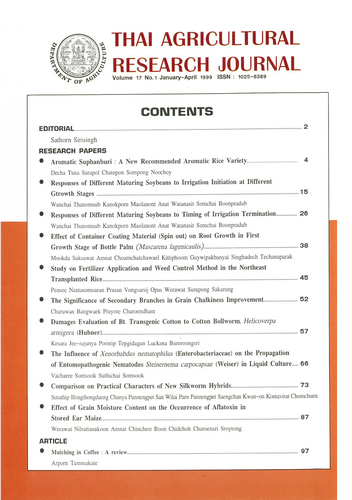Study of Fertilizer Application and Weed Control Method in the Northeast Transplanted Rice
DOI:
https://doi.org/10.14456/thaidoa-agres.1999.5Keywords:
fertilizer application, weed control, transplanted riceAbstract
The experiment was carried out at the farmer's field in Ubon Ratchathari province in 1993 wet season. The split plot in RCB with 4 replications wee done which contain 4 main plots: 1) topdress of urea, on time at 7 days before panicle initation 2) topdress of urea, two times at 7 days before panicle initation and 7 days after panicle initiation 3) green manure: Aeschynomene afraspera 4) no fertilizer application, and 3 sub plots: 1) hand weeding at 30 days after transplanting (DAT) 2) planet junior at 30 DAT 3) no weeding. The results showed that fertilizer applied twice gave highest tillers, and fertilizer applied once or twice were significantly higher panicles than green manure andunfertilizer plots. Both inorganic fertilizer application affected tiller than green manure and nonfertilizer plots. Three weed control methods were not different in term of tillers, panicles, and height. Weed density, however, untreated check plots gave higher population than hand weeding and planet junior, but weed density in main plots were similar. Hand weeding gave the least weed dry weight. Weed weight in inorganic fertilizer plots were higher than green manure and unfertilizer plots which grain yield of two times fertilizer application was highest but no difference from one time application. Yield lost by nonfertilizer plots about 30% from the highest grain yield plots while hand weeding gave more yield about 15% of the untreated plots.
Downloads
Published
How to Cite
Issue
Section
License

This work is licensed under a Creative Commons Attribution-NonCommercial-NoDerivatives 4.0 International License.
Thai Agricultural Research Journal



